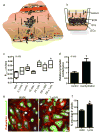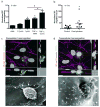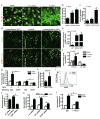Transmural flow modulates cell and fluid transport functions of lymphatic endothelium
- PMID: 20133901
- PMCID: PMC10994404
- DOI: 10.1161/CIRCRESAHA.109.207274
Transmural flow modulates cell and fluid transport functions of lymphatic endothelium
Abstract
Rationale: Lymphatic transport of peripheral interstitial fluid and dendritic cells (DCs) is important for both adaptive immunity and maintenance of tolerance to self-antigens. Lymphatic drainage can change rapidly and dramatically on tissue injury or inflammation, and therefore increased fluid flow may serve as an important early cue for inflammation; however, the effects of transmural flow on lymphatic function are unknown.
Objective: Here we tested the hypothesis that lymph drainage regulates the fluid and cell transport functions of lymphatic endothelium.
Methods and results: Using in vitro and in vivo models, we demonstrated that lymphatic endothelium is sensitive to low levels of transmural flow. Basal-to-luminal flow (0.1 and 1 mum/sec) increased lymphatic permeability, dextran transport, and aquaporin-2 expression, as well as DC transmigration into lymphatics. The latter was associated with increased lymphatic expression of the DC homing chemokine CCL21 and the adhesion molecules intercellular adhesion molecule-1 and E-selectin. In addition, transmural flow induced delocalization and downregulation of vascular endothelial cadherin and PECAM-1 (platelet/endothelial cell adhesion molecule-1). Flow-enhanced DC transmigration could be reversed by blocking CCR7, intercellular adhesion molecule-1, or E-selectin. In an experimental model of lymphedema, where lymphatic drainage is greatly reduced or absent, lymphatic endothelial expression of CCL21 was nearly absent.
Conclusions: These findings introduce transmural flow as an important regulator of lymphatic endothelial function and suggest that flow might serve as an early inflammatory signal for lymphatics, causing them to regulate transport functions to facilitate the delivery of soluble antigens and DCs to lymph nodes.
Conflict of interest statement
Figures






References
-
- Itano AA, Jenkins MK. Antigen presentation to naive CD4 T cells in the lymph node. Nature Immunol. 2003;4:733–739. - PubMed
-
- Pape KA, Catron DM, Itano AA, Jenkins MK. The humoral immune response is initiated in lymph nodes by B cells that acquire soluble antigen directly in the follicles. Immunity. 2007;26:491–502. - PubMed
-
- Randolph GJ, Angeli V, Swartz MA. Dendritic-cell trafficking to lymph nodes through lymphatic vessels. Nat Rev Immunol. 2005;5:617–628. - PubMed
-
- Förster R, Davalos-Misslitz A, Rot A. CCR7 and its ligands: balancing immunity and tolerance. Nat Rev Immunol. 2008;8:362–371. - PubMed
Publication types
MeSH terms
Substances
Grants and funding
LinkOut - more resources
Full Text Sources
Medical
Miscellaneous

